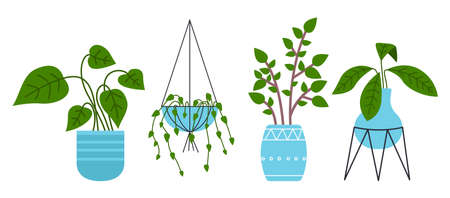1. Introduction: Embracing Green During British Winters
As the frosty breath of winter settles over Britain, a veil of grey often lingers above our cities and villages alike. Rain taps at the windows, the daylight is fleeting, and the long nights can leave even the cosiest cottage feeling a touch forlorn. It’s at this time of year that many Brits turn to cherished rituals—brewing a cup of strong tea, lighting a comforting fire, or donning a favourite woolly jumper—to ward off the gloom. Yet there is an ancient wisdom, rooted in both local custom and global traditions, that invites us to harness the restorative powers of nature within our very homes. The concept of positive Qi—a flow of vital energy celebrated in Eastern philosophy—finds a gentle resonance in British households through the simple act of tending indoor plants. More than mere decoration, these living companions offer a balm for body and spirit alike, purifying stale air and infusing rooms with a sense of renewal. As we explore how greenery can transform our indoor environments during the darkest months, let us rediscover the subtle magic that nature brings—inviting not only cleaner air but also a brighter, more harmonious energy into our winter sanctuaries.
2. The Science of Clean Air: How Plants Lift British Spirits
Amidst the often grey and damp embrace of a British winter, our homes become sanctuaries against the cold. Yet, as we seal ourselves inside, indoor air quality takes on paramount importance—not only for our physical health but for our emotional and spiritual balance as well. Extensive research across the UK highlights how certain houseplants are more than just decorative flourishes; they act as living purifiers, quietly drawing toxins from the air and uplifting the subtle energies within our dwellings.
British Research Insights into Air-Purifying Plants
The Royal Horticultural Society (RHS) and studies from leading British universities have spotlighted several indoor plants with remarkable air-filtering abilities. These plants naturally absorb pollutants such as benzene, formaldehyde, and trichloroethylene—common in UK homes due to cleaning products, paint fumes, and synthetic furnishings. The following table summarises key findings:
| Plant Name | Key Pollutants Removed | British Recommendation |
|---|---|---|
| Peace Lily (Spathiphyllum) | Benzene, Formaldehyde | Recommended by RHS for low-light British interiors |
| English Ivy (Hedera helix) | Mould Spores, Formaldehyde | Endorsed by British Allergy Foundation |
| Spider Plant (Chlorophytum comosum) | Xylene, Carbon Monoxide | Praised in University of Birmingham studies |
| Aloe Vera | Formaldehyde, Benzene | Popular in UK wellness circles for dual healing role |
| Snake Plant (Sansevieria trifasciata) | Toluene, Trichloroethylene | Cited by Kew Gardens for resilience in British homes |
The Physical & Metaphysical Connection: Breathing Life Into Winter Spaces
The benefits of cleaner air ripple far beyond measurable reductions in toxins. NHS guidance recognises that improved indoor air can reduce headaches, fatigue, and respiratory issues—ailments often exacerbated during winter months when ventilation is limited. On a subtler level, many Britons find that harmonious environments elevate mood and foster a sense of positive energy or ‘qi’—a concept borrowed from Eastern philosophy but embraced in contemporary wellbeing practices across the UK.
A Sanctuary for Mind and Spirit
When we invite these living allies into our homes, we create more than a buffer against physical pollutants. Plants are said to radiate calming vibrations; their presence can transform a stuffy sitting room or snug into a space where spirits are gently lifted amidst the gloom outside. This interplay between clean air and balanced qi becomes especially poignant during British winters, encouraging both body and soul to flourish until spring’s return.

3. Living with Nature: The Best Indoor Plants for UK Homes
As the British winter draws in, our homes become sanctuaries against the chill, and bringing the outside in is a tradition steeped in both practicality and folklore. Certain houseplants not only survive but thrive within the unique microclimates of UK dwellings, their resilience echoing the stoic spirit of a windswept moor or a misty woodland glade. These green companions have been cherished through generations, gracing Victorian parlours and modern flats alike, weaving together health, heritage, and harmony.
The Stalwart Snake Plant: A Northern Guardian
The Snake Plant (Sansevieria trifasciata), often called Mother-in-Law’s Tongue, is renowned for its ability to withstand chilly drafts and low light—perfect for dimly lit British winters. Its upright leaves, marked with painterly stripes, were once believed to ward off negative energy, making it a quiet sentinel for positive qi. Beyond folklore, NASA research lauds its air-purifying prowess, filtering toxins while releasing oxygen at night—a true ally for restful sleep during long winter nights.
English Ivy: An Old Soul with Modern Magic
Clinging to ancient stone walls across Britain’s countryside, English Ivy (Hedera helix) brings a touch of wild romance indoors. Victorians admired its evergreen tenacity as a symbol of fidelity and protection. When grown inside, it gracefully tumbles from shelves or hanging baskets, absorbing airborne mould and formaldehyde—making it both an aesthetic delight and a functional friend for those damp, enclosed spaces so common in British homes during wintertime.
Peace Lily: Serenity Amidst the Storm
The Peace Lily (Spathiphyllum) is a classic choice for UK interiors, thriving even in rooms where sunlight is scarce. Its glossy leaves and delicate white blooms evoke purity and calm—a gentle counterpoint to grey skies beyond the windowpane. In feng shui tradition, it is said to harmonise energies and foster tranquillity, while scientific studies confirm its effectiveness in removing indoor pollutants such as benzene and trichloroethylene.
A Whisper of Ferns: Echoes from Ancient Forests
Bristling with lush fronds reminiscent of Britain’s primordial woodlands, ferns like the Boston Fern (Nephrolepis exaltata) have long been favoured for their ability to humidify dry winter air. Their presence conjures images of woodland walks and mossy groves; historically, they were thought to attract fairies and bring luck. Today, they quietly filter toxins from the air while softening urban edges with their verdant abundance.
Nurturing Qi through Local Connection
Selecting indoor plants that resonate with British heritage not only uplifts air quality but also cultivates a living link to the land’s mythic past. Whether you favour robust succulents on a kitchen sill or trailing ivy by the fireside, these botanical allies invite nature’s wisdom into your home—invigorating both atmosphere and spirit throughout the long months of winter.
4. Creating Positive Qi: Plant Placement and Sacred Spaces
British winters, with their muted greys and early dusks, invite us to seek warmth, energy, and serenity within our own homes. Drawing inspiration from the time-honoured traditions of British interiors—think cosy nooks, bay windows, and hearth-centred living rooms—combined with the gentle principles of feng shui, you can intentionally arrange your indoor plants to cultivate positive qi (energy) and harmonious comfort.
Infusing Sacred Energy into British Living Spaces
To foster wellbeing, consider how each room is used and the natural flow of movement through your home. In classic British fashion, window sills are prime real estate for greenery—brightening overcast afternoons with vibrant foliage. Corner spaces, often overlooked in period properties, benefit from tall plants like Kentia palms or rubber trees, subtly redirecting stagnant energy and softening harsh architectural lines.
Tangible Guidance on Optimal Plant Placement
| Room/Area | Recommended Plant | Placement Tip | Qi Benefit |
|---|---|---|---|
| Sitting Room | Peace Lily | Next to fireplace or in a bay window | Purifies air; promotes calm conversation and relaxation |
| Bedroom | English Ivy | On a high shelf or atop a wardrobe | Encourages restful sleep; absorbs toxins from the air |
| Entrance Hallway | Bamboo Palm | Beside coat rack or umbrella stand | Welcomes fresh energy; invites prosperity in winter months |
| Kitchen | Potted Herbs (Rosemary, Mint) | On window ledge or kitchen table | Lifts spirits; supports health and culinary inspiration |
| Study/Work Space | Snake Plant | Near desk or reading lamp | Cleanses air; sharpens focus and creativity during short days |
Aesthetic Harmony: Blending British Character with Subtle Feng Shui Touches
Create sacred spaces by grouping three different plant types together—a nod to both botanical diversity and the trinity motif beloved in British folklore. Use vintage ceramic pots or repurposed teacups for small succulents, layering textures that echo the eclectic charm of an English cottage. Remember: avoid cluttering windowsills or mantelpieces. Each plant should have space to breathe, allowing qi to circulate freely around your home’s heart.
The gentle art of placement transforms even the gloomiest winter day into an opportunity for renewal. Let nature’s quiet power uplift your spirits and infuse every corner with a sense of peace, purpose, and understated beauty.
5. Through the Window: Reflections from a British Winter’s Day
Outside, a gentle drizzle patterns the old glass panes, and the world beyond is cast in the muted greys and silvers of an English winter afternoon. Within, however, the scene shifts entirely—sunbeams occasionally breaking through the cloud cover to illuminate lush leaves perched atop wooden sills. The glossy heart-shaped foliage of a peace lily catches the light, droplets sparkling on its surface like tiny jewels. There’s an unmistakable hush in the air, broken only by the faint tick of the clock and the soft sigh of the kettle warming. In this small flat above a bustling London street, greenery transforms mere shelter into sanctuary.
The rich, earthy scent from freshly watered soil mingles with the aroma of Earl Grey tea, grounding the senses as if walking through a woodland glade rather than sitting at a kitchen table. Each morning has become a quiet ritual—a gentle tending of spider plants and English ivy before breakfast, their leaves brushed softly with fingertips still chilly from opening the window. The act is meditative, a daily invitation for positive Qi to flow through every room.
Through this green company, mood subtly lifts. Even on days when skies remain stubbornly overcast, there’s energy here: an emerald pulse that radiates from every leaf and frond. Friends who visit remark on it—the sense of calm that seems to settle in their bones as soon as they step inside. It isn’t just cleaner air or brighter corners; it’s a living reminder that nature endures, quietly powerful and always present, even when gardens lie dormant under frost outside.
6. Nurturing Nature, Nurturing Self: Winter Plant Care and Mindful Connection
As winter’s hush settles over Britain, tending to indoor plants becomes both a practical act and a soulful ritual. The shorter days and muted sunlight can leave your beloved greenery longing for light, warmth, and gentle care. Begin by placing your plants near south-facing windows where precious daylight lingers longest. Rotate pots weekly to ensure even exposure, and wipe leaves with a damp cloth to allow every cell to soak in what little sun there is.
Central heating can parch the air, so mist your ferns or peace lilies to mimic the moist woodland air they crave, or group pots together to create a microclimate of shared humidity. Water sparingly; most indoor plants prefer their roots slightly dry between drinks during these months. Feed only occasionally, as growth slows naturally—honour their need for restful dormancy just as we yearn for slower rhythms in winter.
This mindful attention does more than sustain plant life; it nourishes your own spirit. Each act of care—a gentle touch, a whispered word, a moment’s pause—deepens your connection to nature’s quiet resilience. In traditional feng shui, plants are living conduits of qi; as you nurture them through the British cold, you invite this subtle energy to flow into your home and heart.
Notice how tending plants shifts your mood on grey afternoons. The vibrant green of an English ivy or glossy rubber plant stands defiant against winter gloom, whispering stories of renewal and hope. Let yourself slow down as you water or prune, using these moments to breathe deeply and ground yourself. As roots anchor in soil, so too can you find steadiness amid uncertainty.
Through caring for indoor plants in winter, you cultivate not only cleaner air but also a sanctuary for your mind and spirit—a gentle reminder that life persists and flourishes even when the world outside lies dormant. Embrace this partnership with nature: each leaf unfurling in your sitting room affirms that spring will come again.

